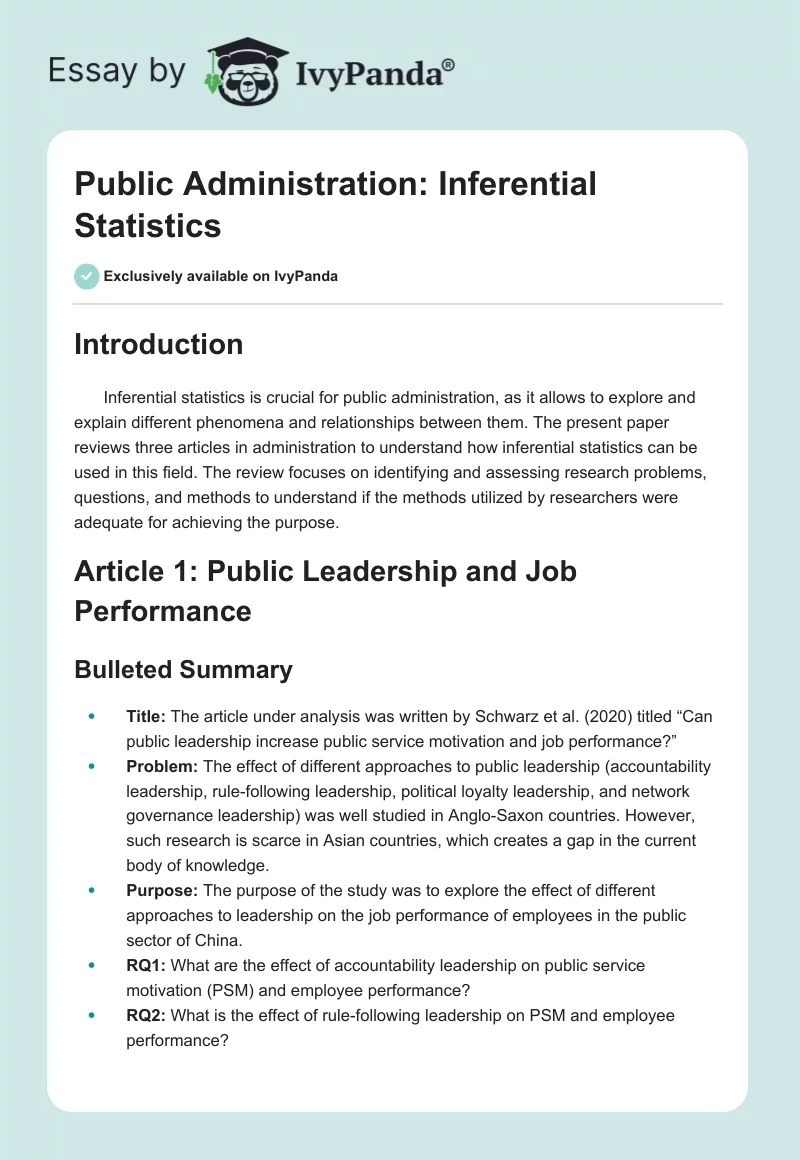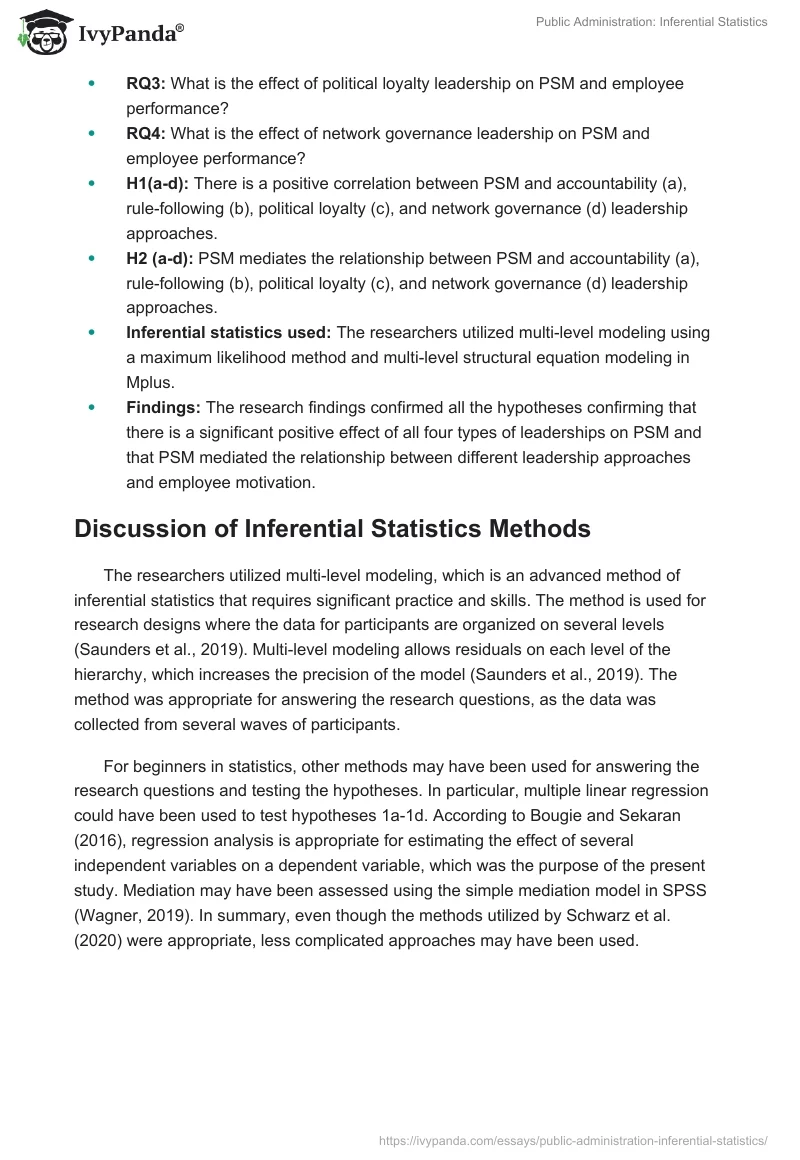Introduction
Inferential statistics is crucial for public administration, as it allows to explore and explain different phenomena and relationships between them. The present paper reviews three articles in administration to understand how inferential statistics can be used in this field. The review focuses on identifying and assessing research problems, questions, and methods to understand if the methods utilized by researchers were adequate for achieving the purpose.
Article 1: Public Leadership and Job Performance
Bulleted Summary
- Title: The article under analysis was written by Schwarz et al. (2020) titled “Can public leadership increase public service motivation and job performance?”
- Problem: The effect of different approaches to public leadership (accountability leadership, rule-following leadership, political loyalty leadership, and network governance leadership) was well studied in Anglo-Saxon countries. However, such research is scarce in Asian countries, which creates a gap in the current body of knowledge.
- Purpose: The purpose of the study was to explore the effect of different approaches to leadership on the job performance of employees in the public sector of China.
- RQ1: What are the effect of accountability leadership on public service motivation (PSM) and employee performance?
- RQ2: What is the effect of rule-following leadership on PSM and employee performance?
- RQ3: What is the effect of political loyalty leadership on PSM and employee performance?
- RQ4: What is the effect of network governance leadership on PSM and employee performance?
- H1(a-d): There is a positive correlation between PSM and accountability (a), rule-following (b), political loyalty (c), and network governance (d) leadership approaches.
- H2 (a-d): PSM mediates the relationship between PSM and accountability (a), rule-following (b), political loyalty (c), and network governance (d) leadership approaches.
- Inferential statistics used: The researchers utilized multi-level modeling using a maximum likelihood method and multi-level structural equation modeling in Mplus.
- Findings: The research findings confirmed all the hypotheses confirming that there is a significant positive effect of all four types of leaderships on PSM and that PSM mediated the relationship between different leadership approaches and employee motivation.
Discussion of Inferential Statistics Methods
The researchers utilized multi-level modeling, which is an advanced method of inferential statistics that requires significant practice and skills. The method is used for research designs where the data for participants are organized on several levels (Saunders et al., 2019). Multi-level modeling allows residuals on each level of the hierarchy, which increases the precision of the model (Saunders et al., 2019). The method was appropriate for answering the research questions, as the data was collected from several waves of participants.
For beginners in statistics, other methods may have been used for answering the research questions and testing the hypotheses. In particular, multiple linear regression could have been used to test hypotheses 1a-1d. According to Bougie and Sekaran (2016), regression analysis is appropriate for estimating the effect of several independent variables on a dependent variable, which was the purpose of the present study. Mediation may have been assessed using the simple mediation model in SPSS (Wagner, 2019). In summary, even though the methods utilized by Schwarz et al. (2020) were appropriate, less complicated approaches may have been used.
Article 2: Public Service Motivation and Ethical Behavior
Bulleted Summary
- Title: The article under analysis was written by Christensen and Wright (2018) titled “Public service motivation and ethical behavior: Evidence from three experiments.”
- Problem: The previous studies found that PSM increased ethical behavior and decision-making. However, there was no experimental confirmation of the matter.
- Purpose: The purpose of the study was to provide experimental evidence to the hypothesis that PSM positively affects ethical behavior and decision-making.
- Research question: What are the relationship between PSM on the one side and ethical decision-making and behavior on the other side?
- Hypothesis: “PSM increases ethical decision-making and behavior” (Christensen & Wright, 2018, p. 2).
- Inferential statistics used: The researchers utilized independent sample t-tests to test if ethical behavior and decision-making between the control groups and experimental groups.
- Findings: The results of three experiments found now confirmation of the hypothesis suggesting that there is no correlation between PSM and ethical behavior and decision-making.
Discussion of Inferential Statistics Methods
Inferential statistics utilized for testing the hypotheses were appropriate. According to Saunders et al. (2019), independent sample t-tests and paired sample t-tests are usually used for experimental studies. These tests are used to understand if there is a difference in means between the two samples. Such approaches are fairly simple in use and provide clear indicators for answering the research question. In this study, the use of the paired-sample t-test was inappropriate, as it can be used only if the data is gathered from the same sample twice. Therefore, no other inferential statistics approach could have been used for answering the research question.
Article 3: PSM and Job Satisfaction
Bulleted Summary
- Title: The article under analysis was written by Gábor (2018) titled “Public service motivation (PSM) and job satisfaction in case of Hungarian local public service.”
- Problem: The information about the effect of PSM on job satisfaction of employees in the public sector in Hungary was scarce before the study was conducted.
- Purpose: The purpose of the research was to study the effect of PSM on job satisfaction of employees in the public sector.
- Research question: What is the relationship between PSM and job satisfaction of employees in the public sector.
- H1: There is a positive correlation between PSM and job satisfaction.
- H2: There is a positive correlation between PSM and resigned satisfaction.
- H3: Red tape strengthens resigned satisfaction.
- Inferential statistics used: The researchers created several regression models to examine the relationships between several independent variables and a dependent variable. Additionally, the researchers utilized correlation analysis.
- Findings: The results revealed that there were positive relationships between commitment to the public interest and job satisfaction, between compassion and job satisfaction, and between self-sacrifice and job satisfaction.
Discussion of Inferential Statistics Methods
Inferential statistics utilized for the study were appropriate to achieve the purpose of the study. According to Saunders et al. (2019), the most appropriate methods to analyze the relationships between variables are Pearson’s correlation coefficient and linear regression. Multiple linear regression can be used to quantify the effect of several independent variables on a dependent variable (Saunders et al., 2019). There may be other appropriate methods to quantify the relationships between several variables, including non-linear regression and multi-level analysis (Wagner, 2019). However, these methods should be used only by very experienced researchers, as they can be used in very specific circumstances.
Conclusion
The present paper demonstrated how inferential statistics can be used by public administration professionals. The paper focused on how PSM could be explored from different angles using various statistical methods. The paper touched upon t-tests, regression analysis, Pearson’s correlation, multi-level analysis, and mediation models.
References
Bougie, R., & Sekaran, U. (2016). Research methods for business: A skill-building approach. Wiley.
Christensen, R. K., & Wright, B. E. (2018). Public service motivation and ethical behavior: Evidence from three experiments. Journal of Behavioral Public Administration, 1(1), 1-8.
Gábor, H. V. (2018). Public service motivation (PSM) and job satisfaction in case of Hungarian local public service. AARMS–Academic and Applied Research in Military and Public Management Science, 17(1), 23-30.
Saunders, M. N. K., Lewis, P., & Thornhill, A. (2019). Research methods for business students. Pearson.
Schwarz, G., Eva, N., & Newman, A. (2020). Can public leadership increase public service motivation and job performance? Public Administration Review, 80(4), 543-554.
Wagner, W. (2019). Using IBM® SPSS® statistics for research methods and social science statistics (7th ed.). SAGE Publications.


